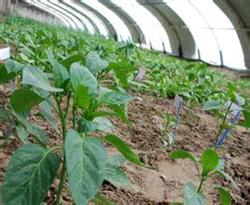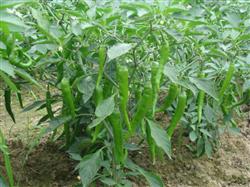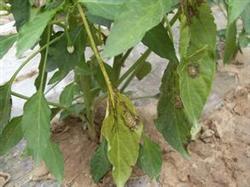Seedling raising and transplanting methods of Pepper

1. Transplanting and irrigation. It can be transplanted after the disastrous weather in the first ten days of April, usually from April 15 to 25. When transplanting, pepper seedlings are required to be 16-17 cm high, 8 true leaves and 50-60 days old. Double plants in each hole, timely irrigation after planting seedlings to ensure the survival rate of planted seedlings. Replenish water in time according to soil moisture after transplanting for a week. 2. Ploughing, irrigation and fertilization. The machine can carry out the first intertillage when it can enter the ground, and ploughing 3 times during the whole period. Pepper enters the peak period of flowering and fruit setting, which requires more water, so it should be irrigated in time, otherwise it will cause falling pepper. Watering a small number of times, can not flood irrigation, to prevent the occurrence of diseases. It is appropriate to keep the field moist by irrigation in the middle and later stage. Combined with three times of intertillage for topdressing, 667m2 applied 5kg urea, 10.2kg Sakefu, 10kg diammonium phosphate and 5.2kg potash fertilizer, and applied 65kg fertilizer in the whole period. 3. Pest control and spraying foliar fertilizer. There are many diseases and insect pests in pepper, and the most serious ones in our region are two diseases and two insects, namely, blight disease, virus disease, cotton bollworm and aphid. Virus diseases are generally in the flowering and fruit-setting period, with drought and little rain, and the incidence is high when there is a large number of aphids. In Rain Water, improper irrigation, flood irrigation, or heavy rain, continuous cloudy days led to the occurrence of epidemic diseases. In the process of prevention and control, prevention should be given priority to and comprehensive prevention should be achieved. At the initial stage of the occurrence of virus disease, 400 times of 20% virus A wettable powder was sprayed once every 7 days for 2 consecutive times. Use 58% metalaxyl manganese zinc 500 times solution, methyl topiramate 500 times solution, spray once every 7 to 10 days, spray 2 times for 3 times to prevent and control the blight. The control of Helicoverpa armigera 667m2 took 1520 ml, high chlorine 25ml 30ml, foliar spray in late July, 2 times in a row. Against aphids 667m2 use 2500 times solution of chloramidine or 10% aphid lice net 20g / 30g, use alternately. If the phenomenon of fertilizer deficiency occurs in the middle and later stage of pepper growth, micro-fertilizers such as potassium dihydrogen phosphate and urea can be sprayed to maintain roots and protect leaves, prevent premature senility and increase yield.
- Prev

How to prolong the launch period of chili peppers in autumn
The area of autumn delayed pepper is large, so farmers are very concerned about how to make full use of the existing natural and facility conditions to obtain higher economic benefits according to the market situation. In production, it is suggested that farmers can take the following measures to achieve the goal: 1. Set up the second film in the greenhouse. In this way, it can be maintained until it is big in normal weather.
- Next

Introduction to the symptoms and control methods of pepper blight
Control methods: 1. Pepper blight is mainly harmful to leaves, fruits and stems, especially at the base of stems. 2. The disease occurs in the seedling stage, mostly from the base of the stem, the disease part appears watery soft rot, the disease spot is dark green, and lodging above the disease part. Prevention and control methods: 1, the implementation of crop rotation, deep turning to improve the soil, knot.
Related
- Where is it suitable to grow horseradish in China? it is expected to see the middle altitude horseradish in Alishan.
- How to prevent tomato virus disease reasonably? (Control methods included)
- Many people like to plant towel gourd on the balcony. What are the main points of this method and management?
- What crops can chili peppers be mixed with?
- Fertilization techniques and matters needing attention in Tomato
- What are the grafting techniques for peach seedlings in spring?
- Harm and control methods of root swelling disease of Chinese cabbage
- What are the pests of sweet potatoes? How to prevent and cure it?
- Symptoms, causes and Control methods of navel Rot in Tomato
- The cause of "Cucumber rotten bibcock" in Farmers' planting Cucumber and its Control Plan

